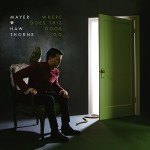By Daniel Janssen
Staff Writer

Mayer who? Mayer Hawthorne, one of the “rising stars” of the past years in the world of soul. Although the man is a late bloomer, with his biggest success album How Do You Do seeing its release after his 32nd birthday, Hawthorne is finally making his way to the big leagues.
After being a DJ in underground hip-hop for a decade, the soul artist is supporting superstar Bruno Mars on his upcoming world tour. Hawthorne, who describes himself as a “smooth dude with a gangster groove”, released his “exploratory” album Where Does This Door Go on July 16th.
Hawthorne brushes his feet on the doormat with a 15-second introduction titled Problemization, a song that includes no more than two lines of text, but still serves as a clever set-up to the storytelling focus of this album as well as a hint at Hawthorne’s smooth groove. The door really opens as soon as the incredibly catchy Back Seat Lover hits the speakers. With a chorus that sends you back to the late seventies, Back Seat Lover blends the groovy tunes of Hawthorne with Hall & Oates into a sexy sing-along.
Although you would expect the album to pursue the upbeat tempo of The Innocent, Allie Jones really slows it down a notch. Looking at all the tracks of Where Does This Door Go, Allie Jones undoubtedly is the odd one out – not just in BPM, but also in vibes. Its reggae flavor does not gel well with the two tracks on either side of the song, making it a dent in the flow of the album. Considering the fact that Where Does This Door Go is a party album after all, Allie Jones is the kid who shows up way before anyone else does. If he had joined the gang a bit later, I’m sure he would have made a lot more friends.
The fifth track, The Only One, shows how far Mayer Hawthorne has come. Combining hip-hop with soul, his well-studied vinyl scratching, with trumpet, piano and poetry, and a catchy chorus, come together to make this song a textbook example of who he is and what he is capable of. Indeed, a “smooth dude with a gangster groove”.
The Only One is the first of three fantastic songs in which Hawthorne flawlessly pulls off his signature style: refreshing soul-inspired song that is classy and slick at the same time. Almost illustrating the latter perfectly, Wine Glass Woman follows with a cheerful yet smooth song that is literally about chatting up classy women.
This groove continues the album’s first single Her Favorite Song, breaking down the soul and jazz into hip-hop and rap. Mayer’s collaboration with Kendrick Lamar, Crime, shows Hawthorne is on his way to the top: the song sounds very familiar, maybe even a bit too much. A reminder of Wiz Khalifa’s sound, Crime is just a bit too gangster as well as easy for the usually quirky Hawthorne.
Fortunately, the remainder of the album sounds as if Mayer was completely aware of his place after all. From Reach Out Richard to the titular Where Does This Door Go, all sound exactly like what you would expect from him, with just enough quirky soul to remain refreshing in the ending tracks Robot Love and The Stars Are Ours.
Where Does This Door Go hints of Mayer Hawthorne’s conformity to chart material, with contributions from famous producers such as Pharrell Williams and Kendrick Lamar, but is easily diverse enough to cover a generation gap from Earth, Wind & Fire to Bruno Mars. Achieving that in an era in which the top of the charts are conquered by a guy in a Beetlejuice suit who grinds girls is very, very impressive.
Daniel Janssen, class of 2015, is a Psychology and International Relations major from Alphen ann den Rijn, the Netherlands.

Loved this album! 🙂